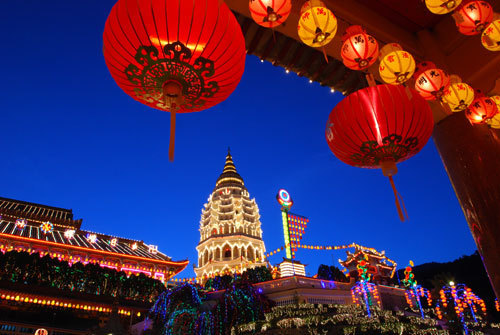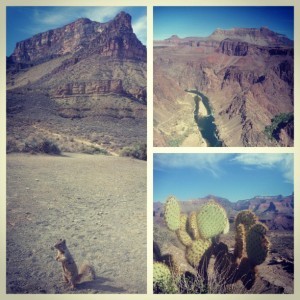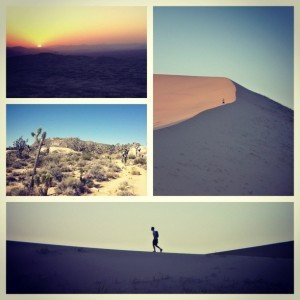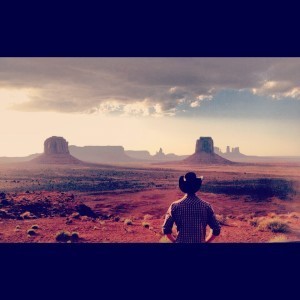Rolf Potts's Blog, page 91
June 8, 2012
Special June 2012 fares for multi-stop tickets on BootsnAll
Vagablogging :: Rolf Potts Vagabonding Blog
 There is so much more to long-term, RTW travel than just traipsing around the globe, seeing famous sites, eating the local food, and just generally being on one long vacation. Long-term travel provides people with the opportunities to try new things and give back to the places they are visiting.
There is so much more to long-term, RTW travel than just traipsing around the globe, seeing famous sites, eating the local food, and just generally being on one long vacation. Long-term travel provides people with the opportunities to try new things and give back to the places they are visiting.
If you’re hoping to leave your home country for an extended period of time, consider teaching English abroad. This is a great opportunity to do something more than just travel – you can actually live in and embrace a local culture, and make some money as well. There is a lot that goes into teaching abroad, so make sure you do all your homework.
Volunteering abroad is also another option for the long-term traveler. Like teaching, there is a lot to know and learn when it comes to volunteer opportunities, and the above article is written by someone who has been on both the volunteering end and the administrative end of companies.
Of course, you don’t have to work or volunteer on your RTW trip, but if you still want to throw yourself into the local culture, consider a home exchange. A home exchange is a great indie travel experience because you are usually staying in parts of a city or town where other locals live, not tourists, so it really gives you an opportunity to live like the locals. You also have a contact in the homeowner that can give you the inside scoop on what to do and where to eat and hang out.
If you do decide to throw caution to the wind and travel the world, the first thing you’ll want to look at is airfare. Your options are many, but be sure to keep your eye on different deals around the web. BootsnAll has monthly deals that can take you all over the world, so be sure to check out the following deals, which are good through June 30, 2012:
Global Adventure -San Francisco – San Salvador – Quito – Lima – Santiago – OVERLAND – Rio de Janeiro – Rome – Madrid – Amsterdam – Nairobi – OVERLAND – Dar Es Salaam – Istanbul – Delhi – OVERLAND – Kathmandu – Hong Kong – San Francisco from $4125 plus taxes.
Grand Caravan – New York – London – Delhi – Chennai / Madras – OVERLAND – Bombay / Mumbai – Cairo – Istanbul – OVERLAND – Athens – Nairobi – OVERLAND – Johannesburg – New York from $3049 plus taxes.
Around the World – Vancouver – Bangkok – Hong Kong – Beijing – Amsterdam – OVERLAND – London – Reykjavik – Vancouver from $2752 plus taxes.
If you are looking for something a little different in your round the world trip, then start planning your trip of a lifetime with our RTW trip planner And don’t forget to sign up for BootsnAll’s RTW newsletter, delivering special deals, RTW trip planning advice, and resources via email every single month. We also have a Facebook fan page and Twitter page, so be sure to like and follow those to keep up to date on all your RTW travel needs.
Original article can be found here: Special June 2012 fares for multi-stop tickets on BootsnAll
Travel technology – translation apps
Vagablogging :: Rolf Potts Vagabonding Blog
Gone are the days of flipping through a phrasebook, frantically trying to find the words to communicate. Today it’s all about the apps, especially if you’re traveling to a country where Internet connections are widespread (and where the spoken language is not an obscure dialect).
A new voice translation app has been riding high on Apple’s Top 25 paid apps list: iTranslate Voice ($0.99). Speak into this nifty little app in any one of 31 languages, and it talks back with the translation in your language of choice.
Why has it become so popular?
First, I’ve found its speech recognition to be superb: it even nailed tough proper nouns like “Tristan da Cunha” on the first try. Second, and most remarkably, it was able to understand my Spanish — and I’m one of those people that speaks with a horrific American accent, the “r” getting stuck in my throat instead of cleanly rolling off. The app also recognized basic phrases that I spoke in German, Italian, French, Portugese and Russian, and translated them correctly each time.
Of course, a voice translation app is nothing new: Google Translate has been around for years, and it has a free app that supports 64 languages, more than double the number offered by iTranslate Voice. The difference? I’ve found that the voice recognition and grammar/syntax of iTranslate Voice (at least going from English to Spanish and vice versa) mostly surpasses that of Google Translate. Though for phrases such as “I’d like the bill/check please,” iTranslate gave me “proyecto de ley” and “el control” instead of the correct “la cuenta,” which Google Translate got for both versions.
For both apps, you need an Internet connection. And people have commented that the apps don’t perform as well for less popular languages (like Norwegian and Polish as opposed to Spanish and French).
My favorite translation app of all time is Word Lens — this one still blows my mind. It translates between English and Spanish/French in real time and onto the video image itself. It works best for standalone signs, rather than full pages of text. The app is free to download but you must purchase “language packs” within the app (e.g., $9.99 for French to English). If you haven’t seen Word Lens in action, definitely spend a minute checking out their demo video.

Word Lens
Which translation apps do you use on the road? Feel free to share your recommendations in the comments.
Original article can be found here: Travel technology – translation apps
Credit card and phone fees—wasteful ways to blow a hole in your budget
Vagablogging :: Rolf Potts Vagabonding Blog
Savvy travelers probably know these things, but I know some who are still behind the curve and going abroad soon. So here’s an update: Though many report having no problems at all using their US mag-stripe cards and ordinary ATM cards abroad, make sure your credit or debit card has a smart chip. The global standard is “chip and PIN” technology, meaning you’ll need to enter a PIN after the terminal reads the card’s chip. Call your credit card company and ask for a new card with a smart chip for the “chip and signature” option. Most cards without the chip will still work sans-PIN at most automated kiosks though, since a signature is generally not needed for purchases under $50.
Another thing to keep in mind when pulling out the plastic abroad: When in doubt, go with the debit card. Though your bank likely charges a currency conversion fee in transactions abroad, credit card fees are usually almost twice as high as debit card transaction fees. Capital One does not charge foreign transaction fees at all, so it may be worth getting one just for your travel use. If you want other card options, the helpful site NerdWallet.com has a list of cards that don’t charge them either.
Roaming charges for calls can be another “under the radar”-type budget buster. Smartphone users can rack up big roaming fees unless they remember to switch on the device’s Airplane Mode and Wi-Fi when boarding the flight to a far-off place. Also remember to switch off the cellular mode.
Data usage costs more money overseas, but the International Data Plans from your provider are rarely the best option anyway; use Skype or Truphone instead (I’m a big fan of Skype) and, with a decent Wi-Fi signal, you can make international calls for dirt cheap. Estimate how much usage you’ll need. There is the ever-handy pay-as-you-go option or a monthly, flat-fee plan that allows unlimited calls in certain countries.
Alternatively, Facebook’s Vonage Mobile app enables globetrotters to make free international calls over Wi-Fi to Facebook friends who also download the app. If caller and recipient have iPhones, FaceTime is a great deal with one flat fee.
Now go have some fun!
Original article can be found here: Credit card and phone fees—wasteful ways to blow a hole in your budget
June 7, 2012
A travel destination can become home
Vagablogging :: Rolf Potts Vagabonding Blog

Kek Lok Si temple @ Penang – Picture by Kit Chan 2010
Most people passing through Penang do so because of the UNESCO World Heritage status given to this Malaysian tropical island on July 7th, 2008. Few stay more than the couple days needed to breeze through the main sites and have a quick gastronomic tour. Even fewer do not complain about the higher beer prices not found in other neighbouring Southeast Asian countries.
“What do you like about this place? You have been here for so long!”
Once again, the tricky question kicks in. Let’s put it this way: after much vagabonding, a destination can become home. At least, for me it did.
I still remember the awe creeping into my own, cutting its way up from the cobbled tiles into my toes, and devouring me as I was strolling down Lebuh Chulia at sunset: a crimson sun playing hide and seek behind the Kapitan Keling Mosque’s dark domes. Across the street, a swarm of rainbow-colored Indian gods orchestrated the evening pujas of their devotees like master puppeteers, while the simmering noise of Chinese delicacies deep-fried at the back of the next alley was the increasing soundtrack to this fading black and white movie.
Day after day, this scenery was my malarial mosquito bite. I quickly forgot what was waiting back there, in my native country of Italy. Quite a destination for some… but nothing compared to this exotic assault to the senses, for me. All of the obligations, the family, friends and opportunities, they all slowly disappeared as watercolor dripping from a water-splashed canvas. Mine was ready to be painted with something new, a vision of brighter colors.
Building up a center around which my life could gravitate was quite a hard task: nevertheless, the process ignited a series of meetings, coincidences and situations that brought me to do what I love – writing and travelling – and calling a new, faraway place as my “home”.
Part of my decision to scratch my itchy travel feet may have been due to the lady I met close to those same fascinating dark domes, three years ago. On the other hand, at that moment I was ready to put down flags around a new comfort zone caved out of my travelling. A very exciting accomplishment I am still proud of up to this day. In a way, it is like marking places we can use as rest areas along the windy vagabonding highway: stop, have a sandwich, use the loo. Then start off again.
In the end, I just lavishly answer: “Because it is beautiful, you just have to scratch the surface”
I try to bury all of the tumultuous emotions I recalled deep into a rapid gaze – and I am very cautious of keeping them to my own mental grave – before I point my interlocutor towards the cheapest beer stall in town. It is a rowdy place tucked away at the corner of a dusty lane, buzzing with swaying people, and looking like a not very secure place to sit and enjoy the locals’ company.
“But… do you think is it safe?” they ask.
“Yes, it is” becomes my final answer.
Original article can be found here: A travel destination can become home
June 6, 2012
Literature as a social icebreaker
Vagablogging :: Rolf Potts Vagabonding Blog
Through the travel website World Hum I discovered an essay that begins with a unique question: “Could geeking out over a mutually beloved novel surpass even alcohol as the ultimate social icebreaker?”
What do you think? Have you bonded with someone because of a novel?
I have!
Bryan Basamanowicz then continues to say, “Quite like the bond formed between travelers on similar journeys, the bond formed around a favorite novel is one of shared immersive experience, usually open to impossibly wide interpretations.”
For me the novel was “The Alchemist” by Paulo Coelho. I had a long standing affection for the book; so when a new hostel roommate (whom I hadn’t met or seen) had left an English copy of it on her bed, I felt compelled to ask her what she thought of it.

book I saw on the hostel bed
Turned out she hadn’t finished reading it yet, however, we became friends anyway; explored the city for a few days together and eventually discussed the book when she was done with it.
Original article can be found here: Literature as a social icebreaker
June 5, 2012
Global data plans becoming more affordable
Vagablogging :: Rolf Potts Vagabonding Blog
AT&T this week rolled out new international data packages with prices cut nearly in half, a change that comes six weeks after Verizon announced a new international data package. Although these options are still more expensive than using an international SIM card, the changes signify progress toward making smartphone internet use more affordable and accessible for travelers.
AT&T’s new international data package tiers, available for these 135 countries, are:
120 MB for $30/month (previously 125 MB for $50/month; there was also a 50 MB for $25/month offered)
300 MB for $60/month (previously 275 MB for $100/month)
800 MB for $120/month (previously 800 MB for $200/month)
Verizon’s new plan, announced in mid-April, provides 100 MB for $25/month with coverage in 120 countries. This is the only package offered; you can add by increments of 100 MB for $25.
While AT&T and Verizon seem to be making headway in the global data market, Sprint and T-Mobile’s packages are not as competitive. Sprint offers multi-country packages covering only 39 countries, and at 40 MB for $40/month or 85 MB for $80/month, the prices are much higher than the others. T-Mobile’s international service is very expensive at $15 per MB.
Original article can be found here: Global data plans becoming more affordable
To blog, to write, or to simply enjoy the moment?
Vagablogging :: Rolf Potts Vagabonding Blog

Photo from roblangimages
What kind of traveler are you? One style certainly isn’t better than another. You may be a tell-all traveler, posting religious updates and photos to a blog and tweeting every hour on the hour. Maybe you’re a personal diary keeper, writing not only to capture the experience but also to work through the roller coaster of emotions on the road. And for every record keeping traveler, there is a do-er who asks: why write when you can simply experience?
As my own 2012 adventure slowly winds down, I am beginning to understand how invaluable a written record of travel can be. I look back through my black moleskine and see that for every week of detailed writing, there is a month of empty pages. I often put myself in the “do-er” category, finding it impossible to write when there were so many exciting things happening around me. I couldn’t believe I would ever forget the colors of that Himalayan sunrise, or the feeling of salty emerald ocean as I dunked in Thailand for the first time.
I brushed off the idea of frequent journal writing and opted instead for doing: for seeing, for experiencing, for living in the moment. I learn now that those weeks I captured in my notebook contain, by no coincidence, the memories that are most clear. Of course, not all journal entries need to be serious. Shorts lists and musings can be just as enjoyable.
My advice? Looking back on travel journals recreates the experience, and I wish I could have captured more. Taking a few minutes to reflect does, in fact, remove you from the “moment,” but at the same time makes the experience permanent. Don’t put off journal writing out of fear of missing out. Memories on the road are fleeting – if you don’t write them down, their vivid colors will fade.
Writing on the road will not only give you something to do in even the dullest moments, it will also keep writing skills sharp and will give you the best souvenir: crystal clear memories, penned by you!
Original article can be found here: To blog, to write, or to simply enjoy the moment?
June 4, 2012
What’s better: a million dollars or a million air miles?
Vagablogging :: Rolf Potts Vagabonding Blog

Boarding passes and luggage tags from airlines. Photo: Julia P. / Flickr
What would you rather have: a million dollars or a million frequent-flyer miles? Airline miles have almost become a new currency. They can be exchanged for hotel stays, car rentals, gift cards, and merchandise. The movie “Up in the Air” with George Clooney brought mainstream attention to “travel hacking.” This is how people use their ingenuity to build up as many frequent flyer miles as possible.
The Los Angeles Times had an article titled The frequent flyers who flew too much. It’s about how American Airlines offered to sell tickets for unlimited first-class travel. This excerpt reveals how these airpass holders acted:
Passes in hand, Rothstein and Vroom flew for business. They flew for pleasure. They flew just because they liked being on planes. They bypassed long lines, booked backup itineraries in case the weather turned, and never worried about cancellation fees. Flight crews memorized their names and favorite meals.
It’s fun to imagine what you’d do you if you fly anywhere, anytime and not worry about the cost. Going to another country becomes as easy as taking a bus. However, all good things must come to an end. The airline changed the terms of the deal.
What happened next is up for debate. Did the airpass holders take advantage of their privileges to the extreme? Or did the airline renege on the offer?
Have you earned free flights? How did you do it? Please share your tips in the comments.
Original article can be found here: What’s better: a million dollars or a million air miles?
June 3, 2012
One meets fascinating people on the beaten path
Vagablogging :: Rolf Potts Vagabonding Blog
“This is the travel platitude to end all travel platitudes: it’s not about the place, it’s about the people. Agreed. So let’s not forget that even on the tourist trail — especially here, come to think of it — you can meet all kinds of people who are interesting and worldly and not at all the stereotype of the shallow sightseer. Improbable kindred spirits you would not otherwise encounter but who will be more than worth your while. And — this is important — because they are often on leave from the military or in town for a conference or just short on vacation time and planning energy, they’re precisely the sort of fascinating people who you won’t meet if you follow only the road less traveled. They’re all the more interesting precisely because they’re not jaded eternal travelers — they have full, rich lives back home, and travel serves as an ice-breaker, not the entirely of the conversation. Some people mock tourists as roving bands of people who are all the same, and though there’s an ounce or two of truth to that, the reality is more complex — they may not be locals, but there’s actually a fair amount of diversity, especially at the big landmarks where everyone wants to go.”
–Doug Mack, Europe on 5 Wrong Turns a Day (2012)
(2012)
Original article can be found here: One meets fascinating people on the beaten path
June 2, 2012
Vagabonding Field Reports: roughing it in the Southwest USA
Vagablogging :: Rolf Potts Vagabonding Blog
Cost: $50/day
What is the strangest thing you have seen recently?
The South Kaibab trail winds its way from the south rim of the Grand Canyon to the canyon floor, roughly 5000 feet (1525 metres) below. It is extraordinarily beautiful and offers spectacular vistas at various points over its seven miles. Because of the brilliant views and easy access it receives lots of foot traffic. So much traffic, in fact, that the rock squirrels in this ‘wilderness’ have become extremely comfortable around humans. Turn your back to admire the view and your trail mix disappears in the clutches of a clever rodent. Squirrels are intelligent creatures and some have worked out how to suckle from hydration bladders. If you leave your pack on the ground one of the little guys may creep up, grasp the bite valve in its fore paws and start quenching its thirst. Extraordinary.
Some people, particularly up on the heavily visited south rim decide to offer up little morsels to the inquisitive squirrels, an act that can end painfully. The squirrels aren’t above biting the hand that feeds them and there are signs warning tourists as much.

Grand Canyon
Describe a typical day.
As the sun rises I wake in my sleeping bag and gaze through the tent at the immense rock walls and across the arid landscape. Mojave, Grand Canyon, Capitol reef, Bryce, Zion are all rich in beauty. Upon waking in the American Southwest one is always met with a pleasing view and wonderment inspired by the bizarre, desolate landscape.
The serenity the view brings me is interrupted by a foul odour. I realize my travel buddy Kevin desperately needs a shower. We have been road tripping from one location to the other, car camping and back packing. Showers have been scarce.
Breakfast is a cheap and easy affair. Multi grain cheerios with powdered milk fits the bill. It’s now time to explore. This is best done by foot and started early to avoid the heat. We hike…and hike….and hike. Before it gets too hot, we have covered a few miles and, depending on the day, gazed upon the sprawling sand dunes of Mojave, sheer cliffs of the Grand Canyon, claustrophobic slot canyons of Zion or other-worldly hoodoos of Bryce Canyon.

Mojave
During the middle part of the day at lower elevations the heat can be intense. If it ‘s going to rise above 100 degrees Fahrenheit (37 degrees Celsius), which it invariably does at this time of the year at the Grand Canyon floor, we rest during the hottest part of the day. From around 10am to 4pm we laze around under the limited amount of shade, cool off in any available streams, eat tortillas for lunch and read something topical. I have borrowed a copy of ‘Over the Edge: Death in the Grand Canyon’ from a rangers station. As the title suggests it describes in detail all the grizzly ways one may expire in and around the Grand Canyon, from extreme heat exhaustion to being pushed from the south rim by a disgruntled spouse. A review on the back describes it as ‘an absolute masterpiece’- it’s no George Orwell but I have a morbid fascination with it. Despite how gripping this ‘masterpiece’ is, I usually fall asleep and take a nap whilst waiting out the heat.
Come 4pm we start hiking again. The visual wonders continue: massive California condors cruise high above us, never flapping their wings as they survey the land for carrion. The sky is a striking blue, noticeably more vivid that the smog tarnished skies of California. White clouds take up curious shapes, seemingly in order to contrast with and enhance the already spectacular horizon.

Hoodoos at Bryce Canyon
Upon arriving at our next campsite, we set up the tent and start cooking dinner. As we eat soup or ramen noodles, we discuss all the delightful foods (anything edible that isn’t ramen noodles) we can feast upon when we return to civilization. We are weary after having covered many miles, however before we turn in we look up at the night sky. Unspoiled by light pollution, we see stars, planets and the Milky Way, sights that our urban lives prevent us from seeing regularly. Then we sleep and do it all over again the next day.
Describe an interesting conversation you had with a local.
We met Salt Lake City native, Rob, coming up the Bright Angel trail to the south rim of the Grand Canyon. He had explored much of the South-West and was accompanied by a German vagabond by the name of Sebastian. They had met each other in Canada and had decided to make their way south to explore some more of Rob’s back yard. They had hitchhiked from Canada to Salt Lake City, where they picked up Rob’s car, and were driving it around Utah and Arizona. At one point, as they drove through Utah, they picked up a hitchhiking homeless man who informed them of some free campsites in the area. They ended up sleeping next to him under the stars at Goosenecks state park before saying their goodbyes the next morning.
Neither hitchhiking nor sleeping next to homeless people seemed to bother them, in fact, quite the opposite; they seemed to revel in the excitement of it all. They loved meeting all the strangers who gave them lifts and were of the opinion that the overwhelming majority of people are kind and generous, and the worst thing that could happen to them was that they could be robbed. Maybe it was because I was reading some morbid literature, but I could think of many more violent and horrible outcomes to their actions.
In addition to their mode of travel, they had slept on the floor of the Grand Canyon without permits and swam in the Colorado River. Both of these activities are against park regulations. According to ‘Over the Edge: Death in the Grand Canyon’ swimming in the Colorado, especially without a life jacket, is fraught with danger. The currents are strong and many people are swept into rapids only for their bodies to emerge several miles down stream, bruised, battered and lifeless. Rob and Sebastian, however emerged unscathed, their only complaint being that it was awfully cold. ‘It was zis cold’ Sebastian said, as he parted his thumb and index finger in a gesture indicating the effect of the frigid water on his manhood.
Sleeping a night in the Grand Canyon corridor without permits can get you in a bit of trouble but it’s not overly dangerous….usually. Rob mentioned that they had been bothered by some foxes during the night and I recalled seeing a warning on a bulletin board at camp informing campers that two foxes had recently been shot in the area after displaying unusual and aggressive behaviour. Tests on their brain tissue had confirmed that they were indeed rabid. After informing the two gentleman of their potentially close call with one of the most horrible afflictions known to man, they seemed unconcerned and mildly amused. They then kindly suggested I stop reading horrifying books.
Perhaps it comes down to how your risk-reward meter is calibrated, as blogger Nancy Sathre- Vogel, discussed in a recent post, but I certainly wouldn’t be comfortable doing some of the things Rob and Sebastian do. I will admit that their stories and sense of adventure did inspire me a little and I have resolved to give hitchhiking a try at some point in the future. Its time for a bit of a recalibration, but you won’t find me hunkered down next to a homeless man any time soon.
What do you like about where you are? Dislike?
I like the spell bounding scenery that seems to surround me at every turn of a trail or highway, and the sense of freedom that comes from living out of your car or backpack and winging it.
I dislike the crowds at some of the national parks, especially come weekend time, however this can easily be remedied by hiking away from the main thoroughfares.

Monument Valley
Road tripping in the USA at the moment is significantly more expensive than it was a couple of years ago, given the price of petrol. There is no getting around the fact that a large portion of your expenses will go towards this if you are driving vast distances. We tried to stay in the same place for a few days and utilize free shuttle services in the National Parks to reduce costs.
Describe a challenge you faced.
Sleeping in close proximity to Kevin, my malodorous companion, in a tent for an extended period of time has brought its challenges. There is a limit on personal space and we have become down right filthy at times, having showered infrequently. Additionally, it is more of an effort to set up a tent and cook on a portable stove than it is to stay in a hotel/hostel room and buy a cheap dinner. As time goes on we have become more efficient and it doesn’t take us too long to make our shelter and cook. Obviously, we are exposed to the elements more than we would be under a roof. We had to sleep a night in the car at a truck rest stop after our tent kept blowing down one night as high wind gusts hit out campsite. We have been rewarded for the challenge in more ways than one: reduction in costs, splendid views of the night sky and clean air.
What new lesson did you learn?
I have long known that the national park system is one of the USA’s best gifts to its people. Phenomenal beauty abounds in a stunning array of landscapes and unique ecosystems that draw visitors from across the country and the world. Humans have long held a reverence for these wild places and many mountains and peaks bare religious names: Abraham, Isaac and Jacob peaks in Zion, Vishnu temple of the north rim of the Grand Canyon. There are even non denominational religious services held regularly at the south rim of the Grand Canyon.
Despite this adoration, just as a religious person does not spend all their time in a church, temple or mosque, no matter how much we love nature we cannot, nor do we want to, live a nomadic existence and truly return to the wild. It has come to the end of my two week tour of the southwest wilderness and, although I have enjoyed my time thoroughly, and want to explore more, I find myself craving the creature comforts of the urban world; comfortable beds, movie theatres and cheap Mexican food await.
Where next?
Guatemala for a month
Original article can be found here: Vagabonding Field Reports: roughing it in the Southwest USA
Rolf Potts's Blog
- Rolf Potts's profile
- 323 followers







